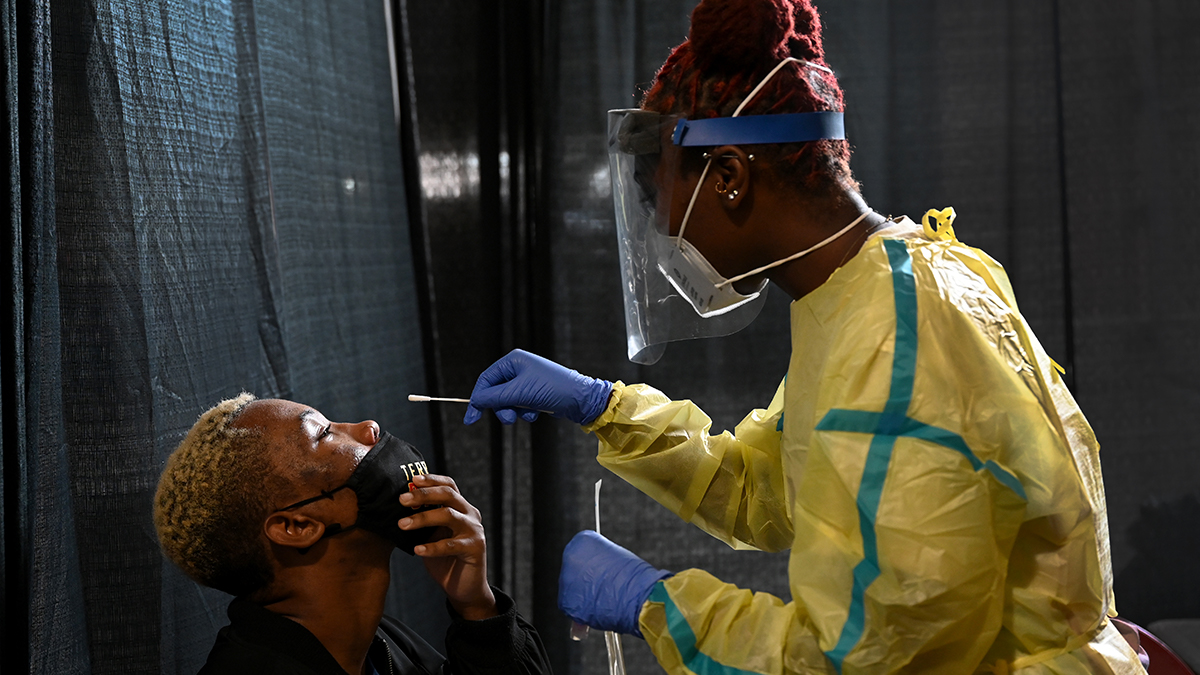Most new COVID-19 cases in D.C. come from social events, according to data presented Wednesday by D.C.’s health department.
More than half of residents who were diagnosed in early October and spoke with contact tracers reported engaging in “high to moderate exposure” activities in which they were in close contact with others before they were diagnosed or developed symptoms.
Nearly 25% of people said they were at a social event with at least five attendees, about 22% said they were at work and about 21% said they were customers at bars or restaurants.
Coronavirus Cases by Neighborhood in D.C.
Source: D.C. Coronavirus Hub Credit: Anisa Holmes/NBC Washington
Last updated Dec. 9
Prince George’s County Executive Angela Alsobrooks says the Largo Motor Vehicle Administration office should be closed after one employee died of COVID-19 and four others tested positive. The facility remains open.
“I would like to see it shut down until we can make everyone comfortable, including the employees who are there,” she said.
Vice presidential nominee Kamala Harris will suspend in-person events until Monday after two people associated with the campaign tested positive for coronavirus.
Harris' communications director and a traveling staff member tested positive after a trip to Arizona on Oct. 8, the campaign told reporters Thursday. The campaign said Joe Biden had no exposure, though he and Harris spent several hours campaigning together during the trip.
Two recent studies published Wednesday in the journal Blood Advances join a growing body of evidence suggesting that blood type may play a role in coronavirus infections and complications.
One of the studies suggests that individuals with blood type O have a slightly lower risk for COVID-19.
Here's where we stand as the coronavirus continues to change our lives in D.C., Maryland and Virginia.
What the Data Shows
D.C., Maryland and Virginia have surpassed 300,000 confirmed cases of coronavirus as of Thursday. Over the past two weeks cases have been on the rise in our region, falling in line with trends seen across the U.S.
D.C. reported 34 new cases of coronavirus on Thursday. Maryland reported 630 cases and six deaths, and Virginia reported 1,078 cases and eight deaths.
Hospitalizations in the region remain high. There are currently 690 patients hospitalized with COVID-19 in Virginia – 103 patients more than two weeks ago. In Maryland, 412 people are hospitalized with the virus, up from 331 people two weeks ago. In D.C., 88 people are hospitalized.
D.C. reported a testing positivity rate of 1.9%, Maryland reported 3.09% and Virginia's rate was 4.7%.
The map below shows the number of coronavirus cases diagnosed per 100,000 residents.
Coronavirus Cases in DC, Maryland and Virginia
COVID-19 cases by population in D.C. and by county in Maryland and Virginia
Source: DC, MD and VA Health Departments
Credit: Anisa Holmes / NBC Washington
Local Coronavirus Headlines
- Montgomery County could roll back reopening after seeing an increase in infections.
- Five employees of the Maryland Motor Vehicle Administration tested positive for COVID-19 and one of them has died, officials say.
- The Fauquier County School Board expects 71% of its students back in classrooms as part of a hybrid learning plan starting Nov. 9.
- Child care capacity is expanding in Maryland under phase three. Montgomery and Prince George's counties opted to remain at current operating levels.
- D.C. reported 105 new coronavirus cases Tuesday, the highest number since early June.
- Gym goers in Arlington, Virginia, will soon take spin classes on an open air training terrace instead of peddling away indoors. Take a look at how it works.
- D.C. updated its list of states subject to travel restrictions because they're considered high risk due to coronavirus. The next updated list is set to be released Monday, Oct. 19.
- A Maryland high school donated the money it raised for prom to an effort to fight COVID-19 when the pandemic forced it to cancel the party.
- D.C. plans to have high school sports return in January.
- D.C. granted permission for six indoor venues to host performances. D.C. also granted permission for the Adams Morgan business improvement district to host outdoor movies.
- A judge sentenced a Maryland man to a year in jail for throwing parties that exceeded capacity restrictions at the beginning of the governor’s coronavirus emergency order.
Reopening Tracker
- D.C.'s mayor extended the city's coronavirus state of emergency to last through the end of the year.
- Maryland child care providers can return to the full teacher-to-child ratios for which they are licensed, state officials said Thursday, and some nursing homes will be able to resume indoor visits.
- Montgomery and Prince George's counties are among those that did not enter phase three with the state of Maryland. Here's a roundup of counties in our area.
- Prince George's County will allow tanning salons, banquet halls and other businesses to open with restrictions. Officials recently adjusted some other rules too. Read more.
- Maryland Gov. Larry Hogan authorized all public schools in the state to begin “safely” reopening because state metrics on the coronavirus show improvements. The state “strongly suggests” that local school districts bring students back into schools but cannot force them to do so, Hogan said. Montgomery and Prince George's schools both affirmed that they were not altering plans to hold classes online throughout the first half of the school year.
- Prince George's County revisited its phase two reopening executive order due to an uptick in coronavirus cases, according to the county executive's office.
- Virginia entered phase three reopening July 1, loosening restrictions on restaurants, stores, gyms and pools. Northam has said more restrictions could be implemented if cases continue to grow.
- D.C. entered phase two June 22, allowing indoor dining, gyms, libraries and houses of worship to reopen with restrictions.
- Montgomery County entered phase two June 19, reopening with restrictions gyms, houses of worship, indoor dining and retail.
How to Stay Safe
There are ways to lower your risk of catching coronavirus. Here are guidelines from the CDC:
- Wear a snug-fitting mask that covers your nose and mouth.
- Avoid being indoors with people who are not members of your household. The more people you are in contact with, the more likely you are to be exposed to COVID-19. If you are indoors with people you don’t live with, stay at least six feet apart and keep your mask on.
- Wash your hands often, especially after you have been in a public place.



